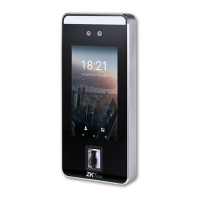SpeedFace-V5L [TI]
User Manual
Page | 70 Copyright©2020 ZKTECO CO., LTD. All rights reserved.
Door Sensor Type
There are three Sensor types: None, Normal Open and Normal Closed.
None: It means door sensor is not in use.
Normal Open: It means the door is always left opened when electric power is on.
Normal Closed: It means the door is always left closed when electric power is on.
Verification Mode
The supported verification mode includes Password/F
Password, Face only, and Face + Password.
Door available time
period
To set time period for door, so that the door is available only during that
period.
Normal open time
Period
Scheduled time period for “Normal Open” mode, so that the door is always
left open during this period.
Master Device
When setting up the master and slave, the status of the master can be set to
exit on enter.
Exit: The record verified on the host is the exit record.
Enter: The record verified on the host is the entry record.
Auxiliary input
configuration
Sets the door unlock time period and auxiliary output type of the auxiliary
terminal device.
Auxiliary output types include None, Trigger door open,
Trigger Alarm, Trigger door open and Alarm.
Verify mode by
RS485
The verification mode is used when the device is used either as a host or
slave.
The supported verification mode includes Card/Fingerprint, Fingerprint only,
Card only, Fingerprint + Password, Card + Password, Card + Fingerprint, and
Card + Fingerprint + Password.
Speaker Alarm
Transmits a sound alarm or disassembly alarm from the local. When the door
is closed or the verification is successful, the system will cancel the alarm from
the local.
Reset Access Setting
The access control reset parameters include door lock delay, door sensor
delay, door sensor type, ver
ification mode, door available time period, normal
open time period, master device, and alarm. However, erased access control
data in Data Mgt. is excluded.
Time Schedule 11.2
Tap Time Rule Setting on the Access Control interface to configure the time settings.
• The entire system can define up to 50 Time Periods.
• Each Time Period represents 10 Time Zones, i.e. 1 week and 3 holidays, and each time zone is a
standard 24 hour period per day and the user can only verify within the valid time period.

